It´s been some days since I´ve published my last article. Sorry for that: Delivery season for me and there are two yachts at one stroke to be handed over, all of that in between a boat show. That´s a lot of stress and virtually no time to write. Anyways, here´s a nice little story I´ve experienced last week when I´ve visited the shipyard and my Omega 42 – a “sidekick” that is going to develop a kind of really big life very soon I think.

Next to ALPHA, my new boat, another hull had been set up to be worked upon in the shed. A small boat, a little longer than 8 meters, very slim with 2 meters and with a fine, sharp entry. Almost a “mini-Omega”, as Heiner, boss of the shipyard told me. In fact, this little boat is the last of a long gone boat project and the first of its class to be revived. May I present the RAN 2 evo.
RAN … what?
The backstory of this boat is as crazy as it is amazing. More than a quarter Century ago a well-known architect decided to not only design but to build a sailboat. This man was Ludolf von Walthausen. Based in Berlin, von Walthausen specialized in sacral buildings and there are many of those to be visited in the western part of Germany´s capital. Apparently, von Walthausen was a keen sailor – Berlin offers a huge sailing area of large lakes, interconnected by rivers and countless canals.
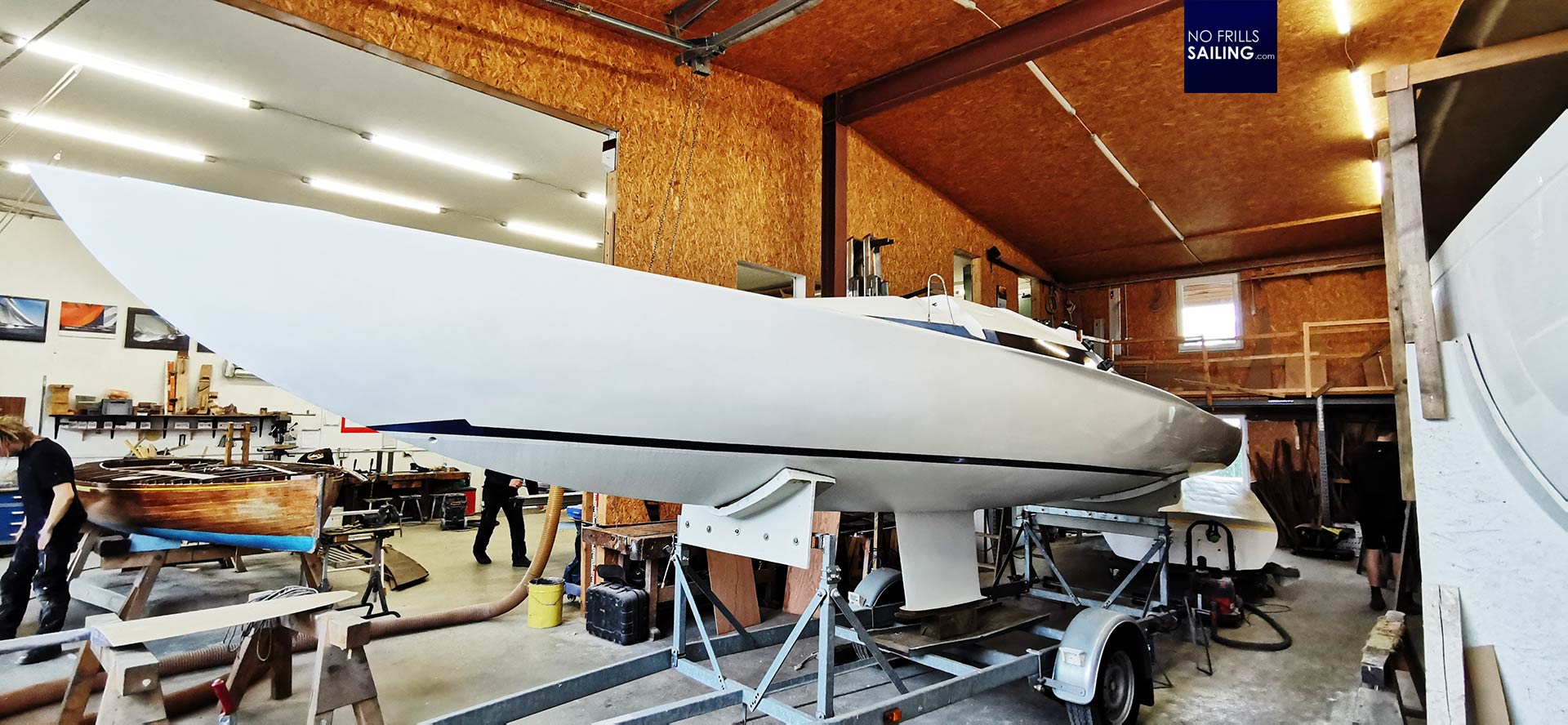
Being an architect himself, the aesthetics of designing a sailboat had not been any problem for him: Looking at the hull of the boat you will have to admire the sharp, fine entry and beautiful line of the bow section – transitioning into a flat, pointy stern section that also comes with a slightly wide and flat rear. I like to “spacy” cabin roof. This boat has something, for sure, still today. Heiner, boss of Mueritz Bootsservice, the shipyard, stands next to me and smiles: “This is our second boat project next to reviving the Omega 42.”, he says and smiles.
A fast, versatile, trailerable sailboat: RAN 2
Ludolf von Walthausen could have simply bought a sailboat for himself and set out for winning the various regattas of Berlin. Back in the Seventies and Eighties, when RAN 2 started her life, there have been a couple of interesting boats we still know today, like the H-boat for example. But he wanted to do his own boat, a small, fast, versatile sailboat that would be easy and fun to sail and easy to transport.

After designing the RAN 2 he built five models that could be sailed remotely. Five iterations of the hull and sailplan, of the keel and rudders. Those models, scale 1:5, helped to find the final hull shape and sailplan. Can you imagine? A time without CAD and CFD analysis, just a pencil, paper and wooden models to check what should be the best iteration? A mould was built, a cast for the keel and two boats came out. Around the early 2000 years, Ludolf von Walthausen´s dream became reality and the boats sailed. He was already an old man.
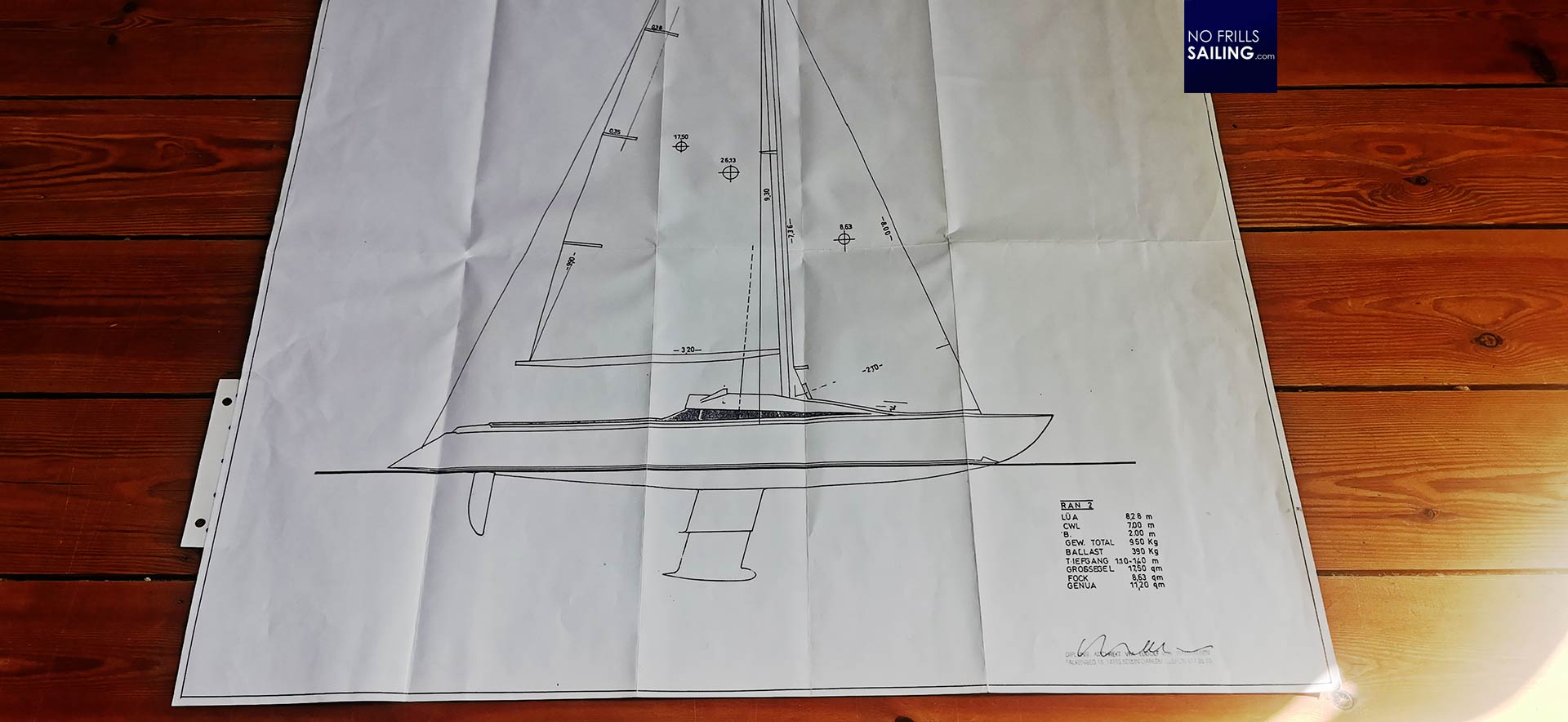
The boat has an overall length of 8.28 meters with a 2.02 meters maximum width. She weighs only 950 kilograms and has a lead-tipped lifting keel with 390 kilograms. That´s a 41 per cent ballast ratio – a hint of her huge stability and stiffness. Projected upwind sails area 26.1 square meters with a 36 square meters Spinnaker. These are a pretty impressive figures: Take the First 27 SE / Seascape 27 as reference: One foot shorter, she has a weight of 1.450 kilograms and needs to carry 47 square meters of sails. A completely different boat, of course, but the RAN 2 is a lightweight flea compared to her.
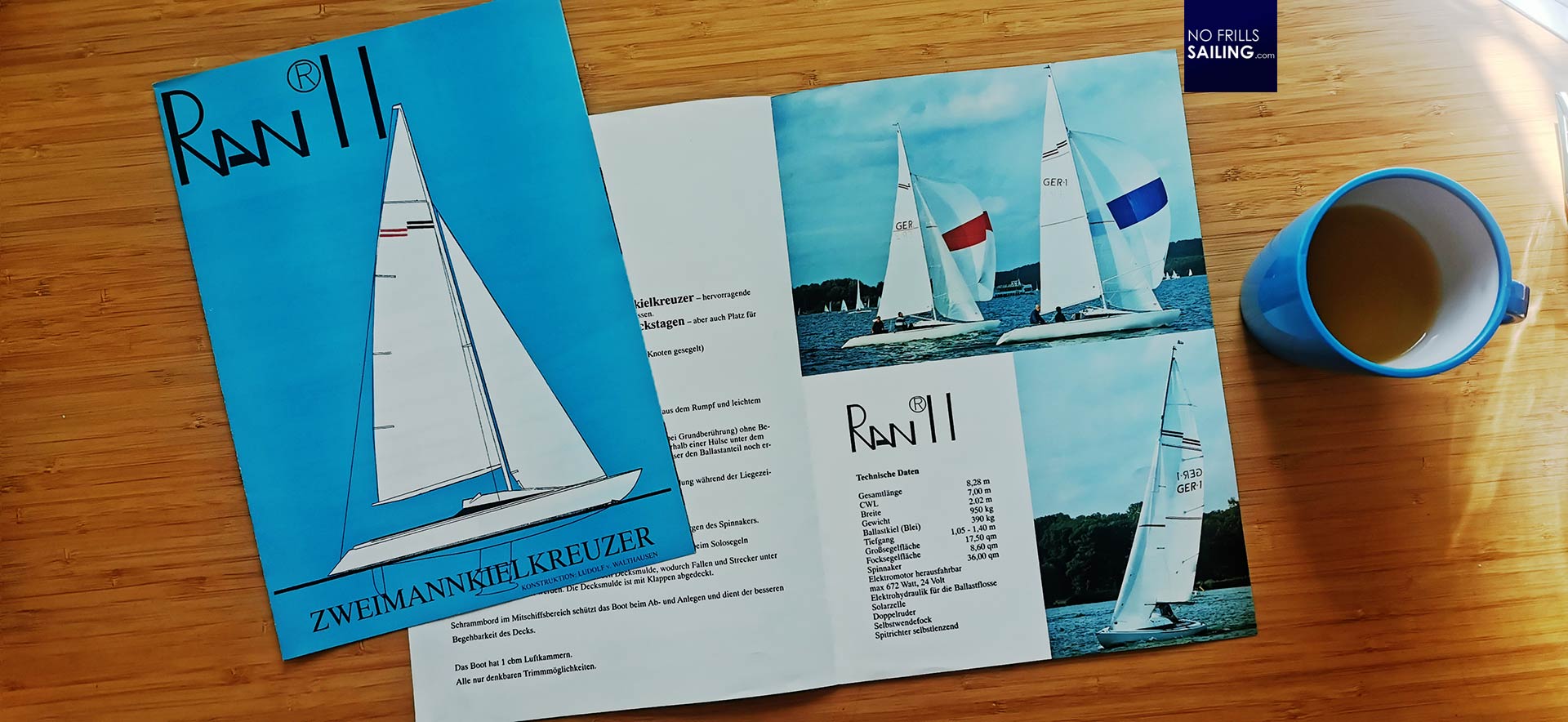
Ludolf von Walthausen sadly couldn´t enjoy all too much sailing. His son did some impressive feats with the prototype but soon the whole project died, along, sadly, with his father and architect. It´s a bit like the story of the resuscitation of the Omega 42: After the residue of Mr. von Walthausen had been managed by the family, over adventurous ways, both one of the RAN 2 prototypes, the plans and the moulds found their way to Heiner. And with them the fascination for this little, strange, beautiful fast boat.
The progressive ideas of Ludolf von Walthausen
It´s not just the weird history and backstory, it´s the boat itself that is fascinating. What seems to be “hyped” and over-communicated nowadays as something brand new and innovative, already had been projected by Ludolf von Walthausen to be standard on RAN 2. I look at the original plans, beautifully drawn by hand, and discover some of those details.
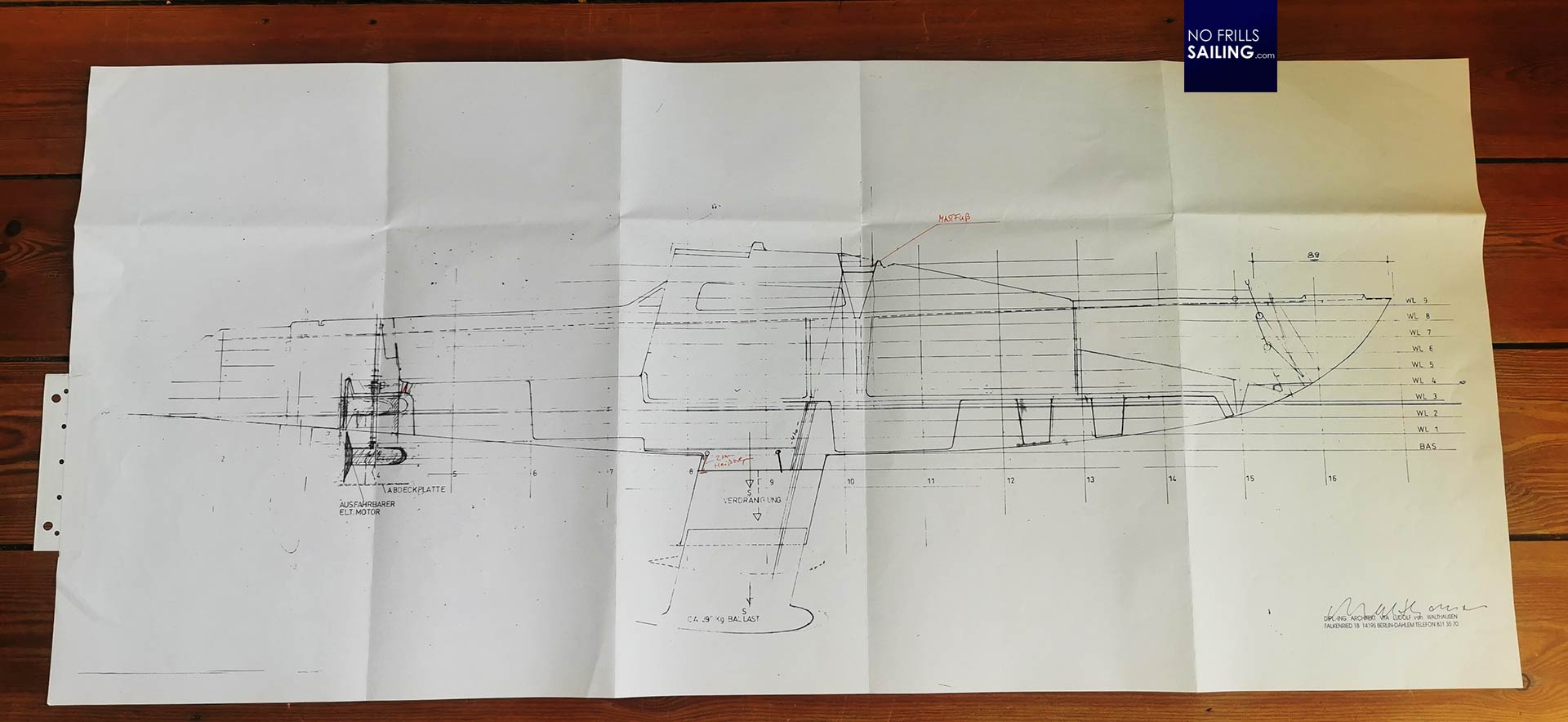
The lifting keel was a trick to not just make the boat much more convenient to be transported on a trailer but to change draft whilst sailing. Von Walthausen envisioned this feature to help the boat perform exceptionally well when going upwind (with keel completely down) and also reduce friction when going downwind, by taking up the keel. Variable draft is a huge thing nowadays.
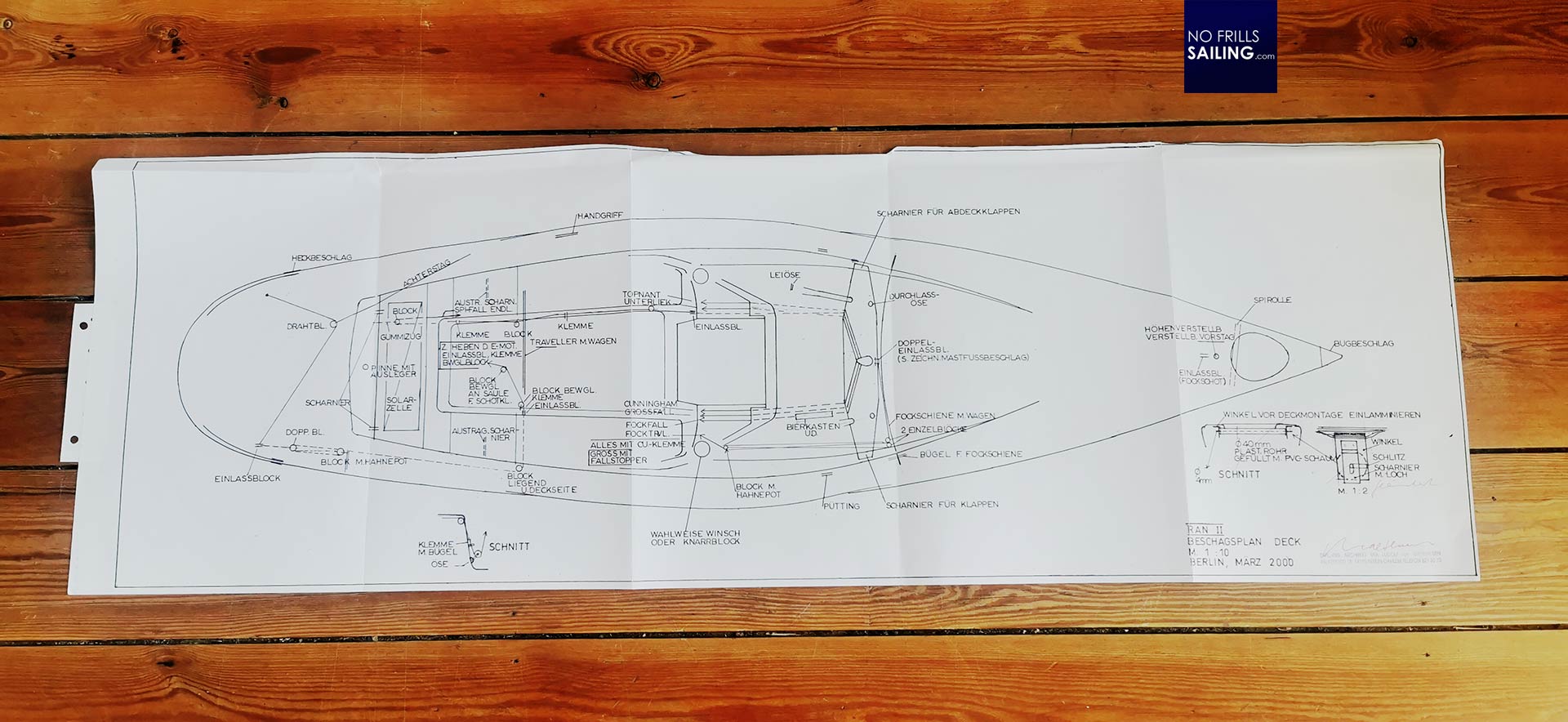
Also, the RAN 2 had been projected to feature a slide-down electric pod drive, which in small boats today seems to be a big fuzz. All of this, and many nice little things more: The RAN 2 is bristling with those. Ludolf von Walthausen apparently was a guy who knew how to do it. Looking at his vision and also going around and inside the finished boat makes me understand why he couldn´t just simply buy one and go out but rather build one by himself.
RAN 2 evo – the prototype is in the making
Heiner and his staff are fond of the RAN. Their bought the moulds and plans and are dedicated to revive this boat. But just as with the Omega 42, their idea is not just to simply build it but to make it better. Or let´s say, make some things fitting our modern times. Maybe one reason why Ludolf couldn´t really “take off” with his boat was a kind of over-complicating the boat. Heiner is a guy who is really good at simplifying and making stuff work.

The lifting keel does not really make a difference, both for sailing and transport. The new RAN 2 evo will have a fixed keel, making operating the boat much easier – and this will create more comforts inside. Also, the complicated double rudder mechanics in the bowels of the stern section: No real advantage to have those (admittedly beautiful) small rudders. Instead, a simple, rigid and effective single rudder will be attached. Again, reducing complicated things to simpler solutions will make things easier. Not just that, it will help to keep a low price for this boat.
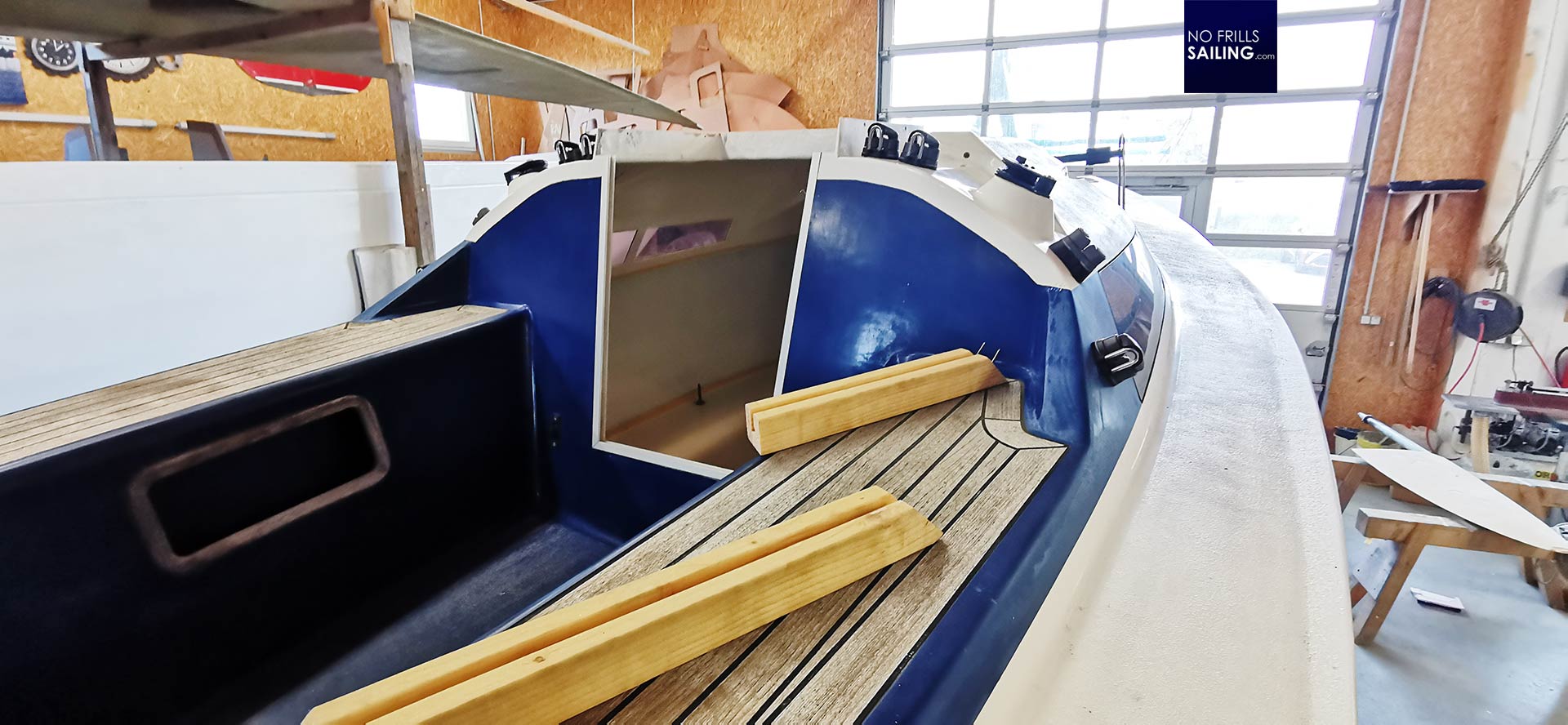
The form of the boat won´t be touched. Ludolf von Walthausen envisioned a simple rigg that could be operated from the cockpit solely. Heiner is going to close the Spinnaker hatch in the bow – something you cannot do nowadays – and instead will have fitted a simpler and much easier to operate setup of Gennaker and Code 0 lightwind sails. Again, skipping the integrated Spinnaker snuffer will create more volume inside.
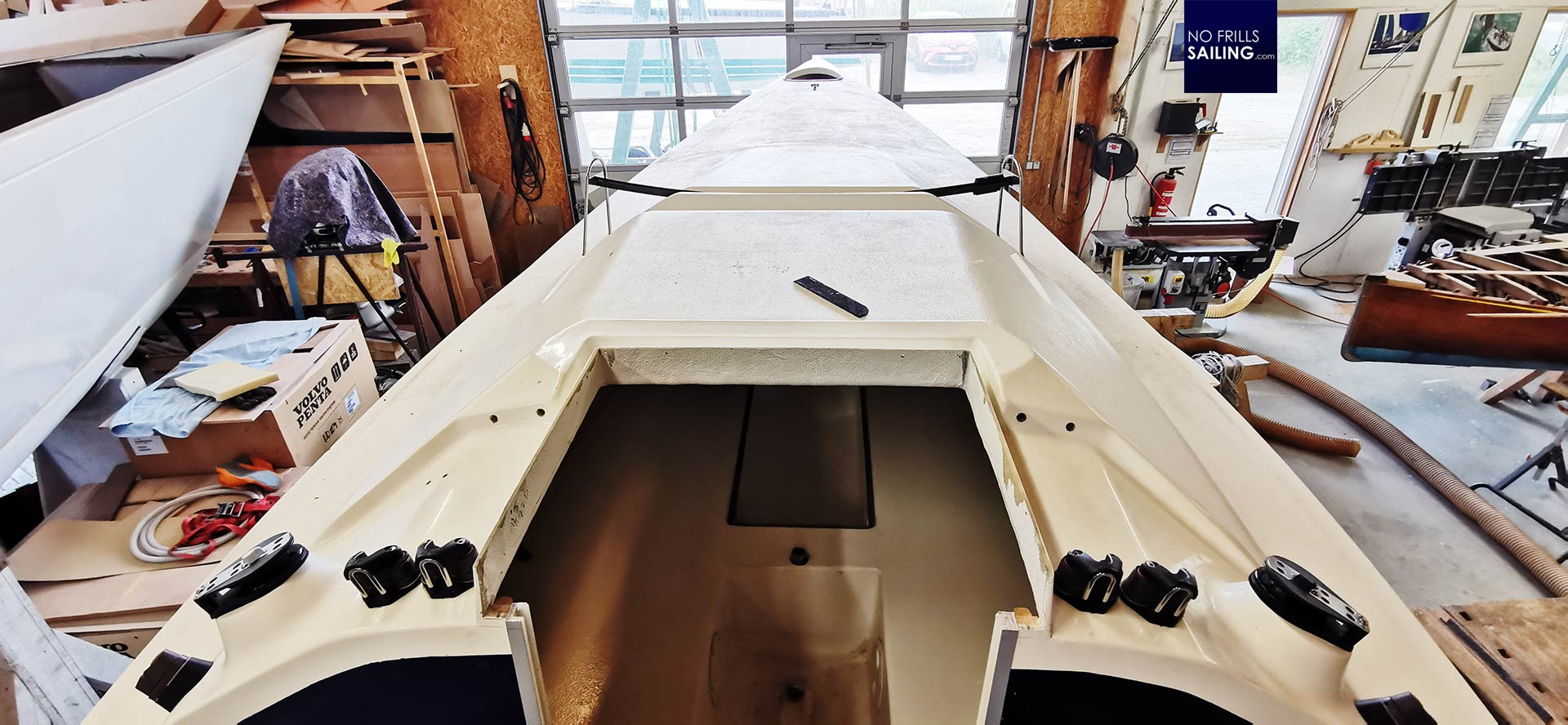
A set of brand new sails is already produced. The prototype of the RAN 2 evo – which at the same time is the last of the original boat – is now under development in the shipyard. The plan is to have her sailing in June or July this summer to gather information, adjust the rigging, tweak the sails setup and maybe do some development iteration of the keel and rudder. This will then be incorporated into the first new RAN 2 evo which will then, hopefully, be the first of many boats to come.
A soupcon of English sophistication …
I climb inside the cockpit which really reminds me of the H-boat. A classic tiller-steered boat, high coamings and everything well within reach. The RAN 2 evo is a sailing machine, she is and does not need to be a roomy cruising wonder: Heiner appreciates the approach and ideas of von Walthausen exactly for this: A boat made to sail fast and make fun on every point of sail. Of course, she needs to have some comforts, right? No problem, she will. We play around with some ideas for her interiors, for the colors and general approach. For some reason the boat reminds me of the classy English luggers and yachts. So, why not make her … English?
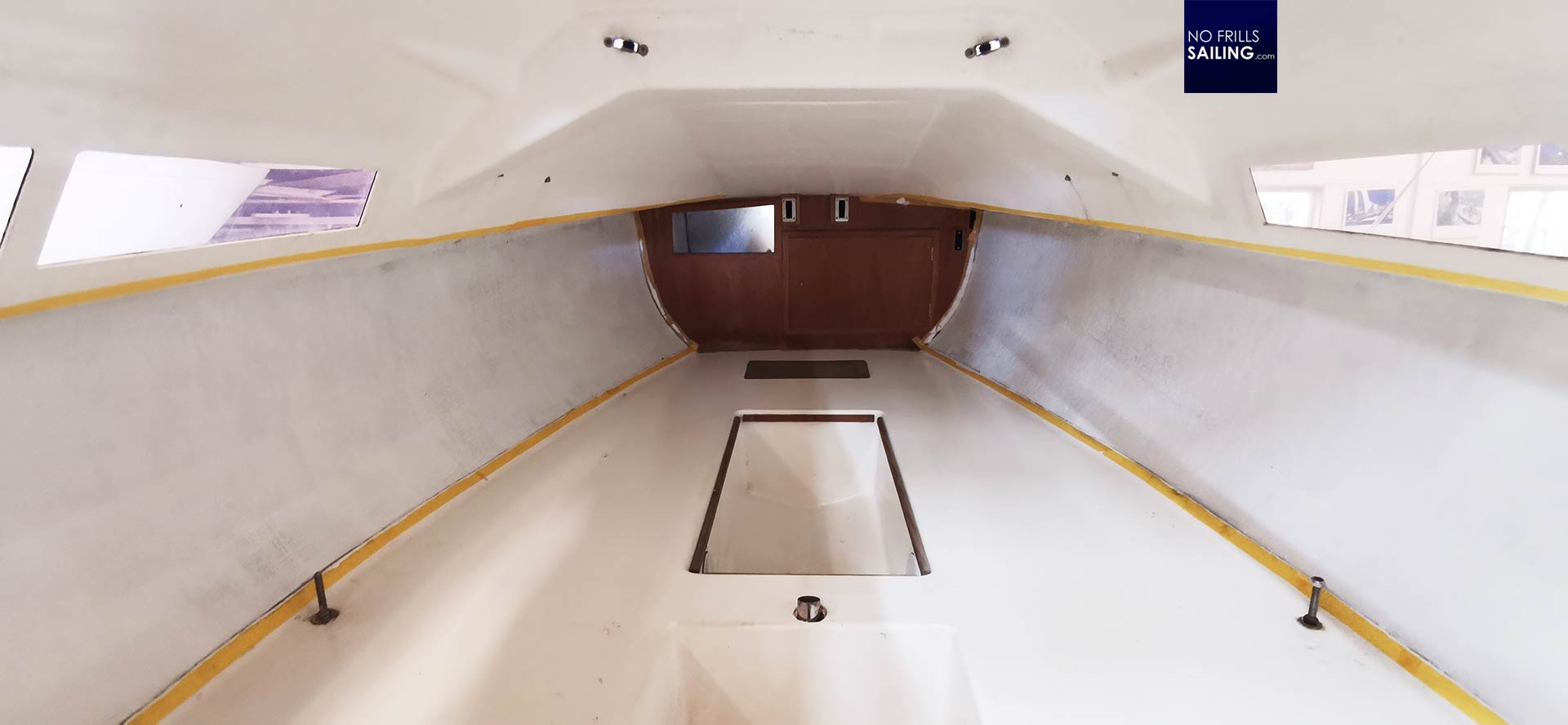
Her cabin is surprisingly spacious. There is more than enough space to fit two side benches which could maybe combined with some cushions to form a huge bed more than suitable for two adults. Because of the fact that there won´t be the heavy lifting keel mechanism anymore, the mid-section can be used to fit some stowage. I like the comparatively large window area making for a light suffused, welcoming interior with lots of natural light.
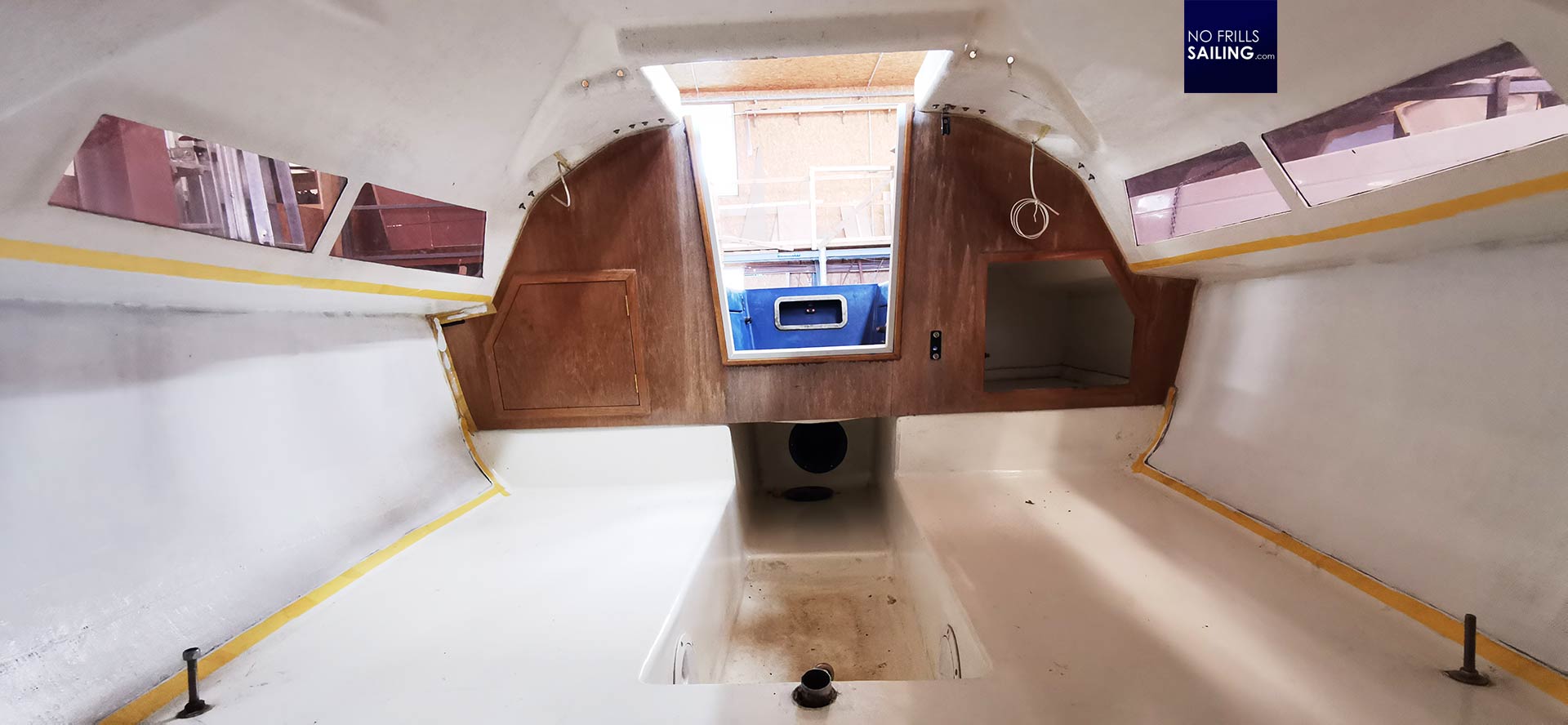
The idea is to make the boat feel “British”. Maybe using some checkered or Scottish plaids for the cushion, have some simple, light but beautiful wooden accents as interior or to come up with British “themes”, three or four, to have pre-designed environments: “James Bond”, “Braveheart” or “Lady Di” or something. We will see. The good part is, Heiner´s wife is a skilled lorimer owning a business providing cushions, tarps and all sorts of saddling products for boats.
First boat in the water by June
Sounds interesting to you? It certainly is! This mini-Omega can be something to spice up the current boat market for small boats. Since prices soared and especially the former bread-and-butter size of 30 to 38 feet for the “normal” middle class became so expensive, many people keen on sailing switch from offshore and coastal cruising to their inshore sailing areas “next door” and invest in small boats. Daysailing and weekending is a huge trend, RAN 2 evo can become an interesting offer for people looking for something special, light and fast to sail.

Heiner and his team are going to prepare the prototype for seatrials and some autumn boat shows here in Germany. I think the Lake Constance could be a nice sailing area where the RAN 2 evo makes sense. With a projected price of around 100.000 Euros this can be an interesting and more than competitive offer. Let´s see – in the meantime I hope they do not focus solely on the little, but also on my big Omega 42 …
You might as well be interested in these articles:
Go small – go now! About the pros of owning a small boat
Creature comforts on my small boat
Hydraulic keel maintenance made easy
